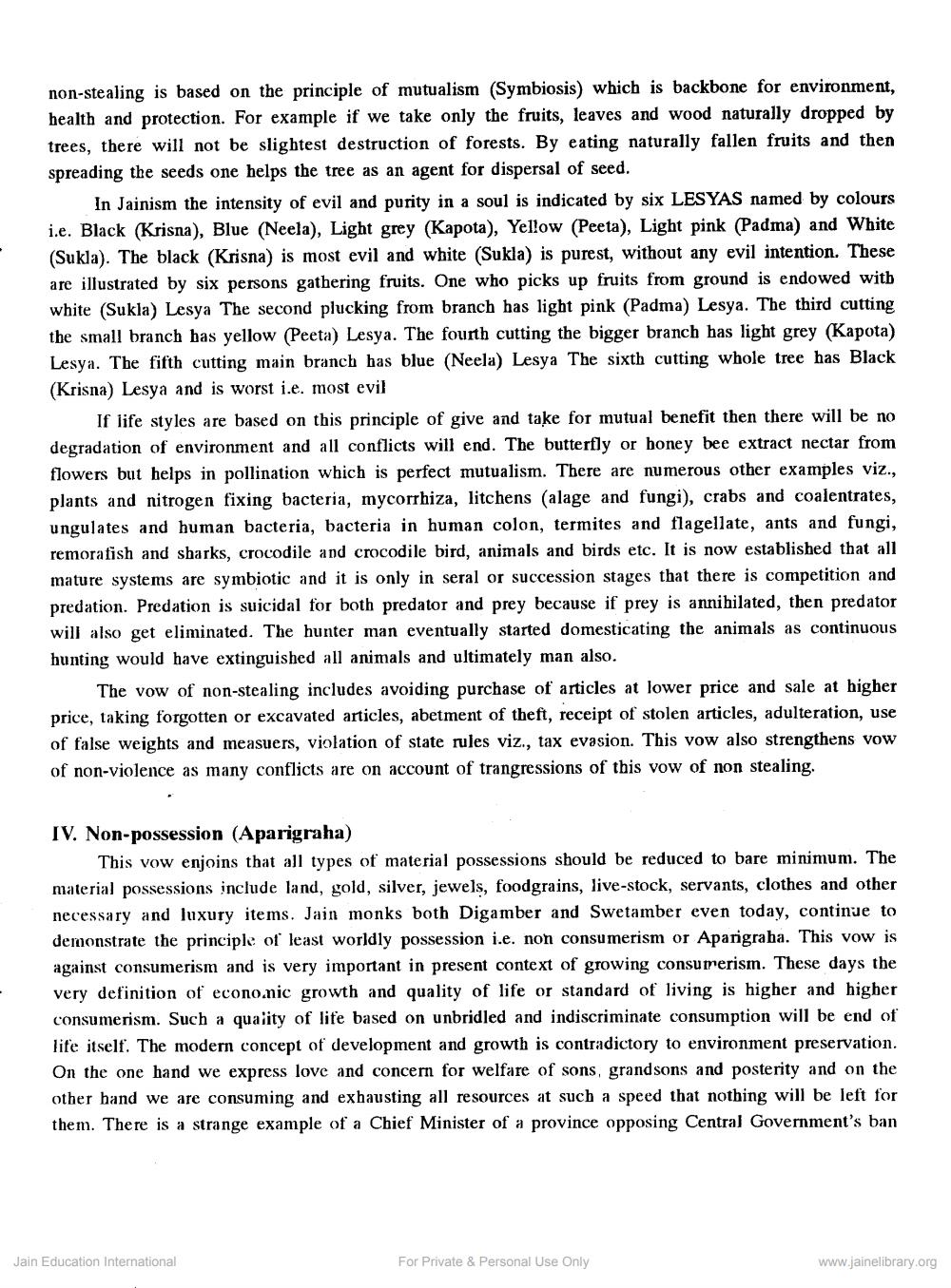________________
non-stealing is based on the principle of mutualism (Symbiosis) which is backbone for environment, health and protection. For example if we take only the fruits, leaves and wood naturally dropped by trees, there will not be slightest destruction of forests. By eating naturally fallen fruits and then spreading the seeds one helps the tree as an agent for dispersal of seed.
In Jainism the intensity of evil and purity in a soul is indicated by six LESYAS named by colours i.e. Black (Krisna), Blue (Neela), Light grey (Kapota), Yellow (Peeta), Light pink (Padma) and White (Sukla). The black (Krisna) is most evil and white (Sukla) is purest, without any evil intention. These are illustrated by six persons gathering fruits. One who picks up fruits from ground is endowed with white (Sukla) Lesya The second plucking from branch has light pink (Padma) Lesya. The third cutting the small branch has yellow (Peeta) Lesya. The fourth cutting the bigger branch has light grey (Kapota) Lesya. The fifth cutting main branch has blue (Neela) Lesya The sixth cutting whole tree has Black (Krisna) Lesya and is worst i.e. most evil
If life styles are based on this principle of give and take for mutual benefit then there will be no degradation of environment and all conflicts will end. The butterfly or honey bee extract nectar from flowers but helps in pollination which is perfect mutualism. There are numerous other examples viz., plants and nitrogen fixing bacteria, mycorrhiza, litchens (alage and fungi), crabs and coalentrates, ungulates and human bacteria, bacteria in human colon, termites and flagellate, ants and fungi, remorafish and sharks, crocodile and crocodile bird, animals and birds etc. It is now established that all mature systems are symbiotic and it is only in seral or succession stages that there is competition and predation. Predation is suicidal for both predator and prey because if prey is annihilated, then predator will also get eliminated. The hunter man eventually started domesticating the animals as continuous hunting would have extinguished all animals and ultimately man also.
The vow of non-stealing includes avoiding purchase of articles at lower price and sale at higher price, taking forgotten or excavated articles, abetment of theft, receipt of stolen articles, adulteration, use of false weights and measuers, violation of state rules viz., tax evasion. This vow also strengthens vow of non-violence as many conflicts are on account of trangressions of this vow of non stealing.
IV. Non-possession (Aparigraha)
This vow enjoins that all types of material possessions should be reduced to bare minimum. The material possessions include land, gold, silver, jewels, foodgrains, live-stock, servants, clothes and other necessary and luxury items. Jain monks both Digamber and Swetamber even today, continue to demonstrate the principle of least worldly possession i.e. non consumerism or Aparigraha. This vow is against consumerism and is very important in present context of growing consumerism. These days the very definition of economic growth and quality of life or standard of living is higher and higher consumerism. Such a quality of life based on unbridled and indiscriminate consumption will be end of life itself. The modern concept of development and growth is contradictory to environment preservation. On the one hand we express love and concern for welfare of sons, grandsons and posterity and on the other hand we are consuming and exhausting all resources at such a speed that nothing will be left for them. There is a strange example of a Chief Minister of a province opposing Central Government's ban
Jain Education International
For Private & Personal Use Only
www.jainelibrary.org




